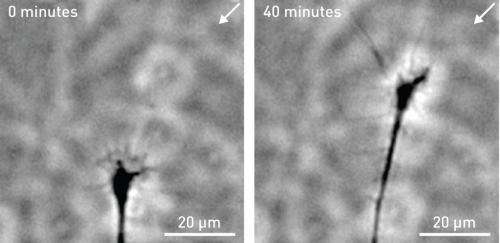Steering the filaments of the developing brain

During brain development, nerve fibers grow and extend to form brain circuits. This growth is guided by molecular cues (Fig. 1), but exactly how these cues guide axon extension has been unclear. Takuro Tojima and colleagues from the RIKEN Brain Science Institute have now uncovered the signaling pathways responsible for turning growing nerve fibers, or axons, toward or away from guidance cues.
The researchers previously showed that axon-repelling cues act by inducing the removal of cell membrane—a process called endocytosis—from the side of the axon closest to the repulsive cue. The enzyme PIPKIγ90 is known to be involved in endocytosis in axons during certain types of synaptic activity, so the researchers investigated whether PIPKIγ90 also played a role in endocytosis during axon turning. By examining the developing brains of chicken embryos expressing an inactive form of PIPKIγ90, the researchers found that cues normally inducing endocytosis were no longer effective in repelling axon growth.
Cues that normally attract axons do so by driving membrane addition—exocytosis—on the side of the axon closest to the cue and also by suppressing endocytosis. Tojima's team found that axons continued to be attracted to such cues even in the absence of PIPKIγ90, suggesting that PIPKIγ90 signaling is not involved in axon attraction.
The activity of PIPKIγ90 is known to be regulated by an enzyme called CDK5, a subunit of which binds to the protein kinase CaMKII. The researchers found that by inhibiting CDK5 or CaMKII, and thereby blocking the regulation of PIPKIγ90 that is needed to suppress endocytosis, endocytosis could occur in response to attractive cues.
They also found, however, that blocking CDK5 or CaMKII did not have any effect on endocytosis if the neurons expressed a mutant version of PIPKIγ90 that was unaffected by CDK5 and CaMKII signaling. As inhibitors of CDK5 or CaMKII did not alter endocytosis in response to repulsive cues, the team's findings indicate that different signaling pathways are responsible for turning axons toward or away from guidance cues.
Additionally, Tojima and his colleagues showed that they could induce the attraction of axons toward drugs that inhibit endocytosis, suggesting that being able to control the direction of axon growth has potential therapeutic applications. "We hope our findings will aid in the development of future therapeutic strategies for rewiring neuronal networks after spinal cord injury and neurodegenerative diseases," explains Tojima.
More information: Tojima, T., Itofusa, R. & Kamiguchi, H. "Steering neuronal growth cones by shifting the imbalance between exocytosis and endocytosis." The Journal of Neuroscience 34, 7165–7178 (2014). DOI: 10.1523/JNEUROSCI.5261-13.2014

















